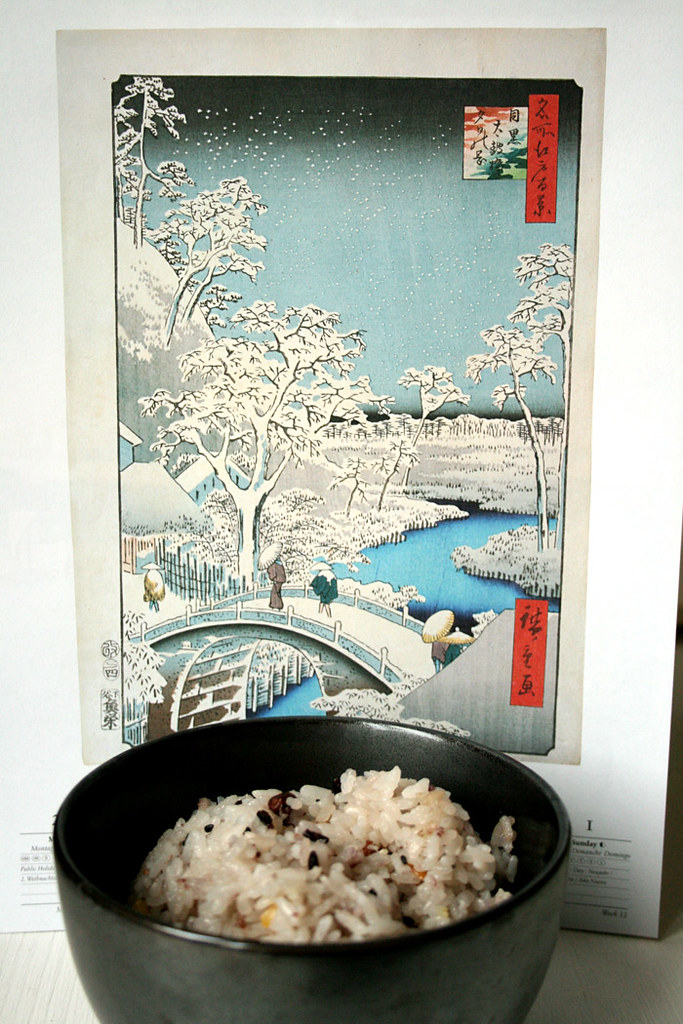
The other day at my local Asian market -- which is usually not very well equipped since importing food from Asia to an unsignificant little island kingdom like Denmark is incredibly pricey -- I found these bags of grains. And I remembered the many crazy versions of rice I often came across when living in Tokyo. Blue, green, dotted in all colours, with grains, with beans, with nuts, anything you'd be sane enough to drop in a rice cooker.
Japanese consumers are obsessed with the terms "fresh" and "new". In supermarkets and
konbinis in Japan products are constantly being introduced, killed-off or moved around in the store to create the impression of variation and new experiences every time you enter the shop = more consumption, more shopping.
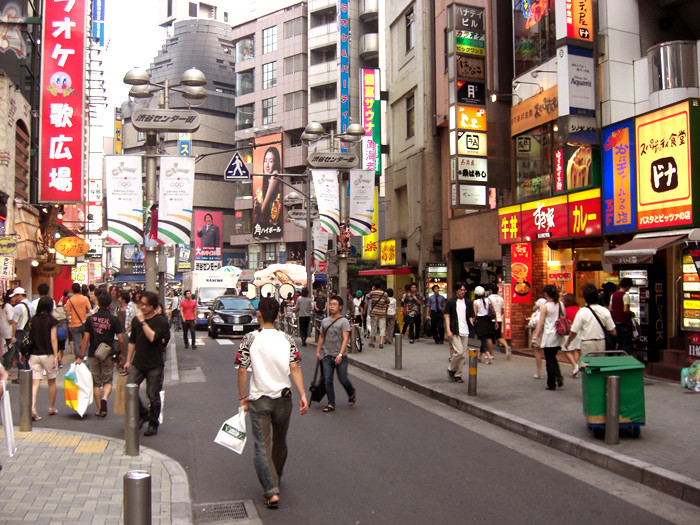 Shibuya: A normal day of skanky shopping.
Shibuya: A normal day of skanky shopping.
As fellow Umamimart writer Yoko has mentioned several times in her Japanify coloum, new flavours of a well known product are introduced constantly, and quite often those flavours are more a gimmick than a real addition to its brand. Like Green Tea Coca Cola, Vanilla Licorice Beer or
Mango Pudding Kit Kat. They may not taste super good, but they invoke a sensation in the consumer's brain and a quick 10 second reminder of its brand in the surrounding cacophony of other brands across the globe. It's all about staying afloat in people's minds, no matter the cost.
 Caramel Corn candy bags - why just one corn flavour when we can have six? Strawberry Corn, Tomato Corn, Peanut Corn, Green Tea Corn, Almond Corn and Vanilla Corn.
Caramel Corn candy bags - why just one corn flavour when we can have six? Strawberry Corn, Tomato Corn, Peanut Corn, Green Tea Corn, Almond Corn and Vanilla Corn.
Japan makes you buy stuff -- and that's exactly what many urban Japanese do: work/eat/shop/sleep (wait hold on, they barely sleep since their work schedule is so intense. And also there's very little sex involved -- the Japanese are so over relationship fornication according to many recent studies. Many young, urban Japanese past their 20's prefer to stay living at home with their parents and then spend their salary on fun with friends, foreign travels, izakaya dinners and shopping. And the shops know that.
Which means whenever you find yourself on a first class seat to Tokyo, make sure you brought lots of empty suitcases to bring back your new junk.
 Tokyo, 2008: Psyched out Anders high on a mixture of sugary green tea ice cream overdose and Tokyu Hands toy department shopping frenzy:
Tokyo, 2008: Psyched out Anders high on a mixture of sugary green tea ice cream overdose and Tokyu Hands toy department shopping frenzy:
"Look, Yoko -- I'm shopppiiing! How about this bed? Should I buy it? Does it fold for the plane ride? What do you think, Yoko? Oh those sheets over there are lovely, I'll take two of those! Wow, check out those Muji designer bunny slippers! Do you think they come in white male sizes?"
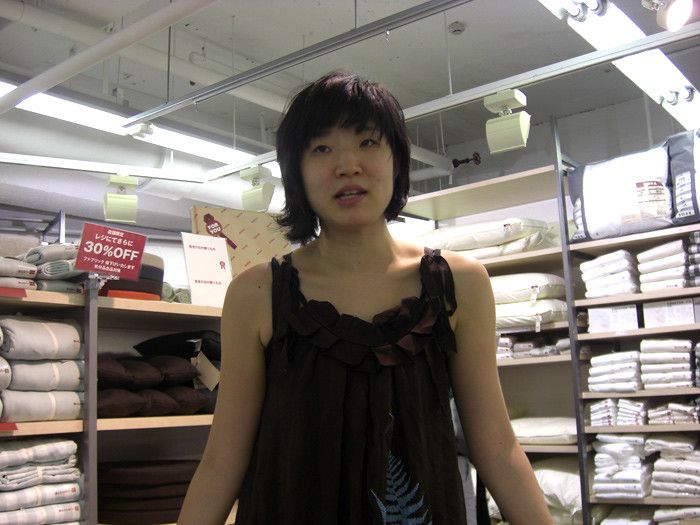 Yoko: "Get me out of here".
Yoko: "Get me out of here".
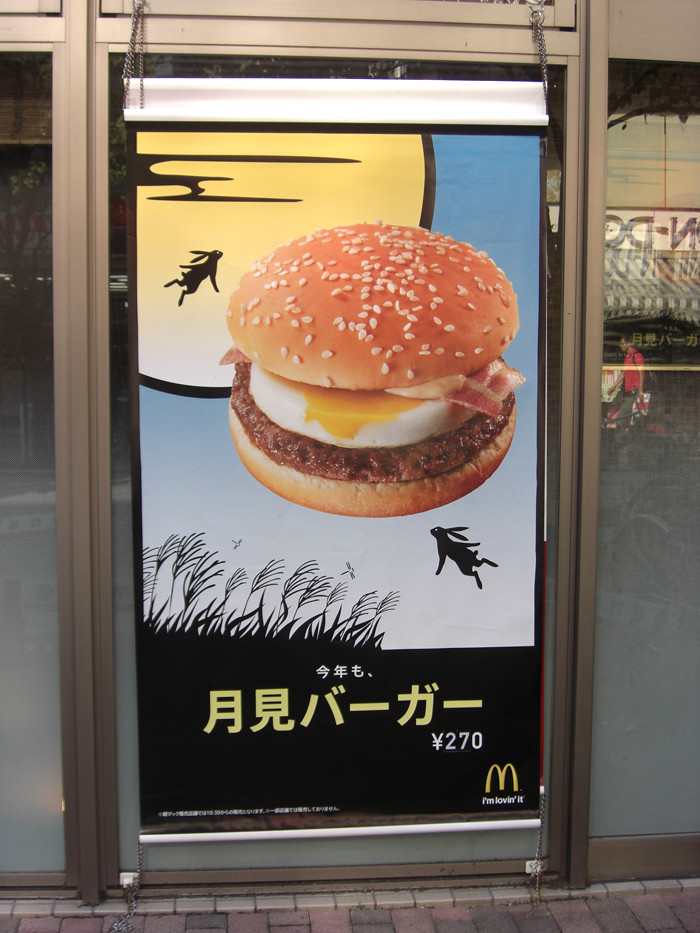 Chopped baby bunny meat burger. Kidding. Sort of, I think.
Chopped baby bunny meat burger. Kidding. Sort of, I think.
But sometimes this crazed up
variation shopping machine isn't so bad. It's actually quite exciting now and then. And I really really miss this energy and creativity among the brands in Danish supermarkets. Every five years there MIGHT be introduced a new flavour of a classic chocolate bar here, but it will probably be "Almond" or "Soft Toffee" or something generic, really thought-over and well-tested with consumers. Yawn, you say? I agree. Then again, Red-Bean-Paste-Whole-Grain-Spearmint Kit Kat probably wouldn't sell truckloads here. However, a little craziness now and then would be fun here in Denmark.
Back to the rice mix:
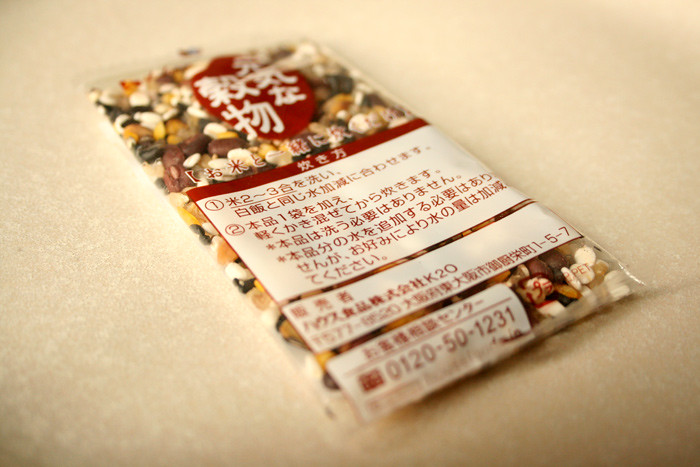
Super cute package.
It says げんきなこくもつ which best can be translated as "happy, vigouris richness". Which is exactly what it brings to your plain, white boring rice.
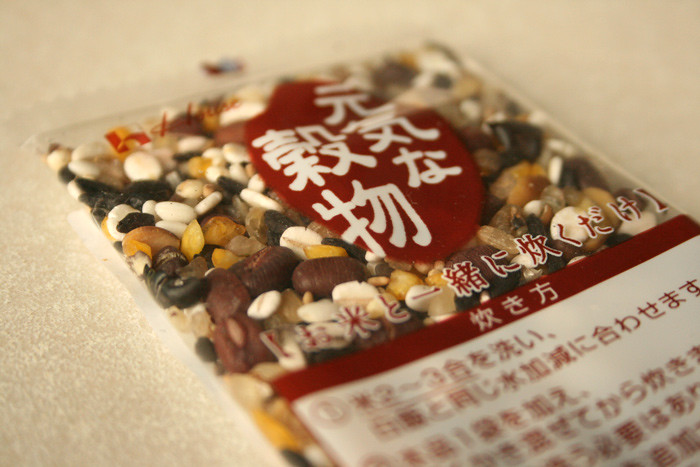
Danish ingredient list stuck on the back by the import company lists the ingredients:
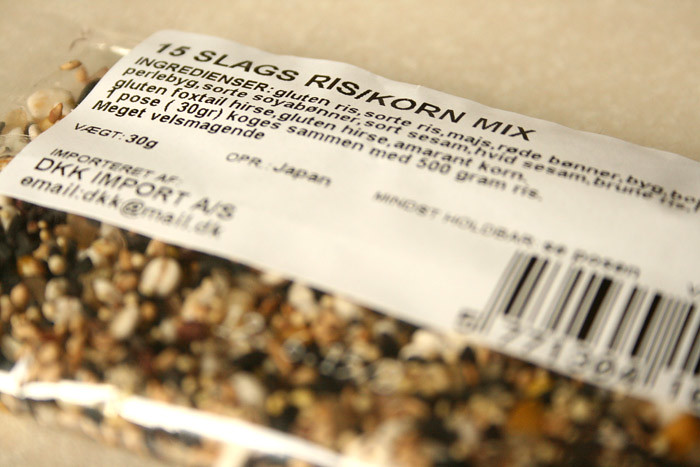
This is 15 kinds of rice/grain mix: Gluten rice, black rice, corn, red beans,, barley, buckwheat, pearl barley, black soy beans, black seseame, white sesame, brown rice, white sorghum, gluten foxtail millet, gluten millet and amarand grains.
WOW! That's a whole lotta grainz.
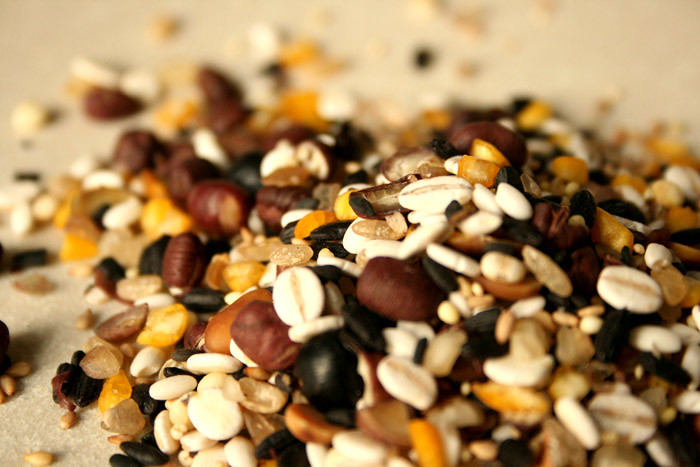
Sounds like something the organic crazies here in Copenhagen would happily sprinkle on their tofu ice cream.
It says this bag goes with 500g rice which is exactly 4 cups.
Many Western people claim that rice doesn't really taste of anything and it's all the same. Well, not quite.
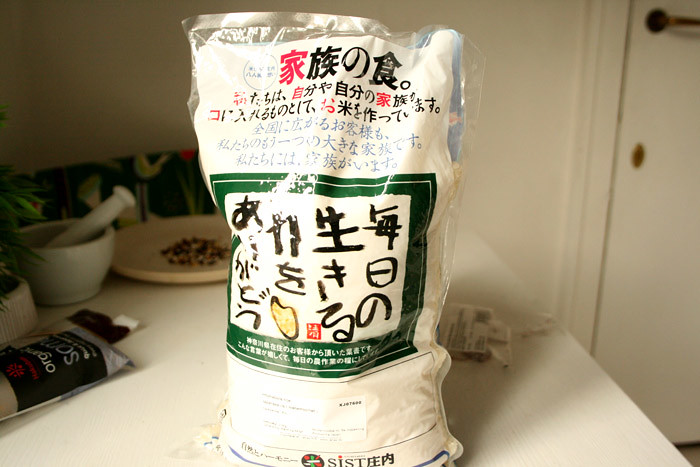
The world of Japanese rice is an abundant cornicopia of brands that offer thousands of different textures, subtle flavours and qualities.
My latest disappointment in my fellow Danes was last week when I went to the
Kung Fu Izakaya Bar in Copenhagen. A Japanese izakaya-inspired place with wooden interiors and cozy lighting. All was good until we sat down and the starter miso soup with a bowl of Indian basmati rice was placed in front of me. SHOCK HORROR! You can NOT serve Indian rice in a Japanese izakaya, it's like serving expensive salmon nigiri sushi with ketchup on the side (something that will send you straight to hell). Needless to say the rest of the dishes were also an abomination and we left hardly having touched the food.

This is my preferred rice at the moment.
Hitomebore rice, a middle grain sort which is developed in Japan but grown in the US. I used to buy cheaper brands at the Asian market, but this is so much better. It's about $23 for a bag of 2.5 kg which is probably a little pricey for American or Japanese standards.
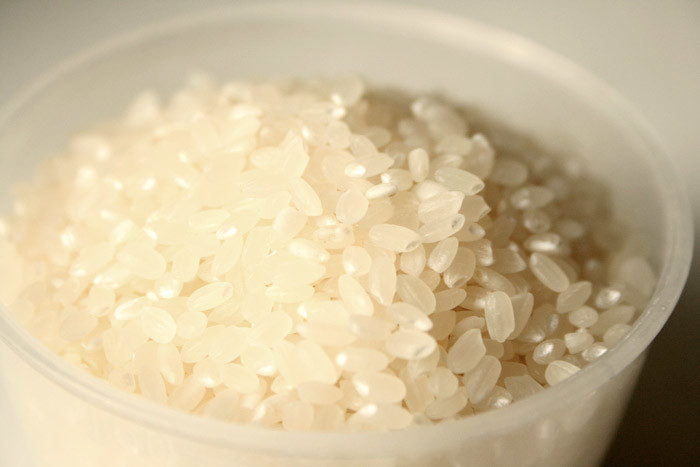
The owner of my local Asian market told me yesterday that their container from Japan was finally delivered after being held back for two months in customs since there are only 3 freight companies in Denmark that scan for radiation contamination (supposedly everything from Japan is scanned before crossing the border to the EU. Hmm I didn't know that, but I guess it makes sense).
So again, back to the rice:
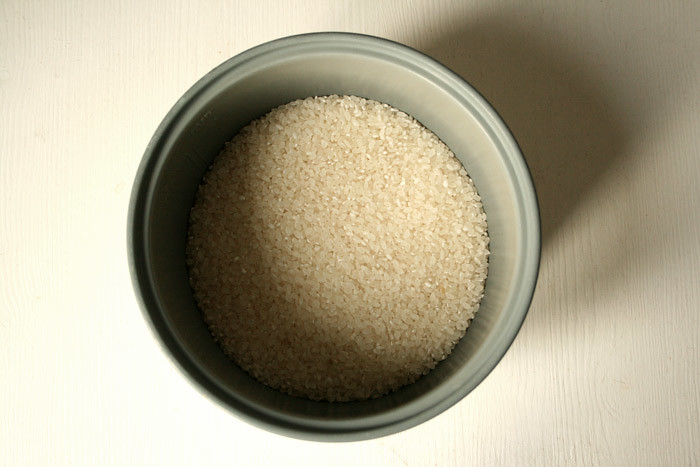
I put 4 cups of rice in my rice cooker bowl. Wash gently 4-5 times until the water is somewhat clear.
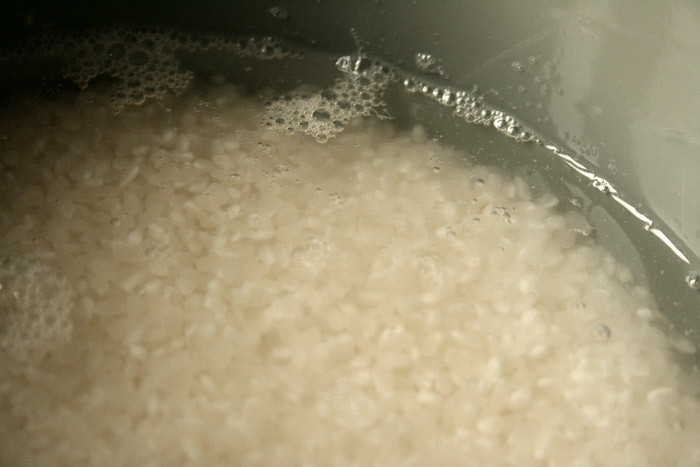
Pour out all water, add approx 4 cups of new fresh water and let it soak for 10 minutes.
Put in the bag of happy, vigorious richness and mix around.
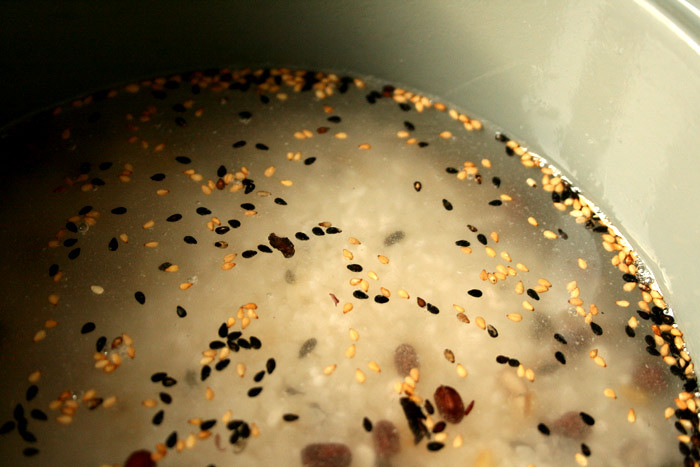
Place the cooking bowl in the rice cooker and start cooking.
While we wait for the vigorious rice, I want to show you the best Christmas present I got this year: A "Famous Views of Edo" week calendar from Taschen, painted by one of the most famous uki-e painters
Hiroshige (1797 – 1858).
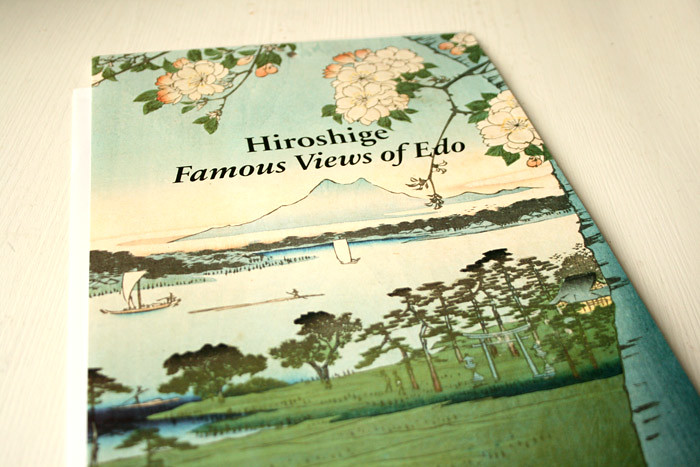
Edo was the old name for present day Tokyo and the paintings in the calendar show the nature around the old capital, the life of its inhabitants and the many incredibly scenes from a world long gone.
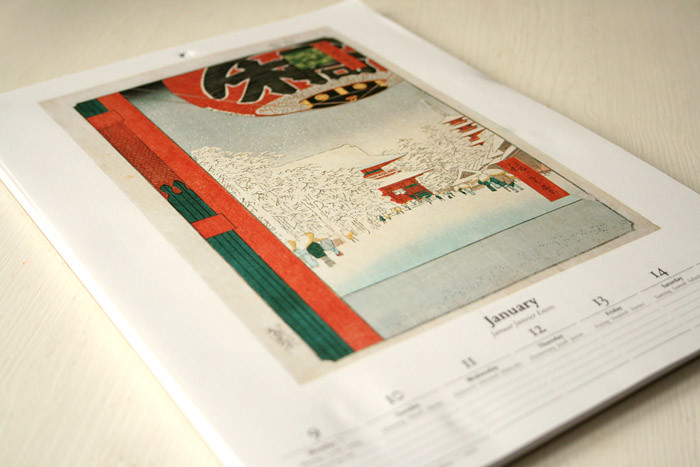
What must a foreigner have thought when coming to Japan the first time back in this age? Everything must have been so aesthetic, so beautiful -- and yet so raw. A hard-knock life.
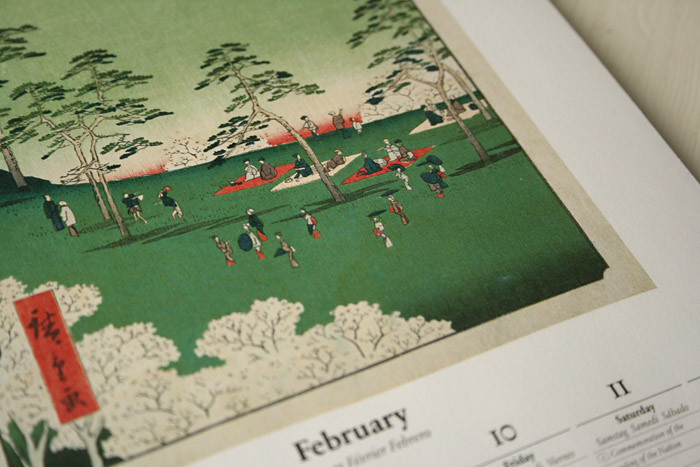
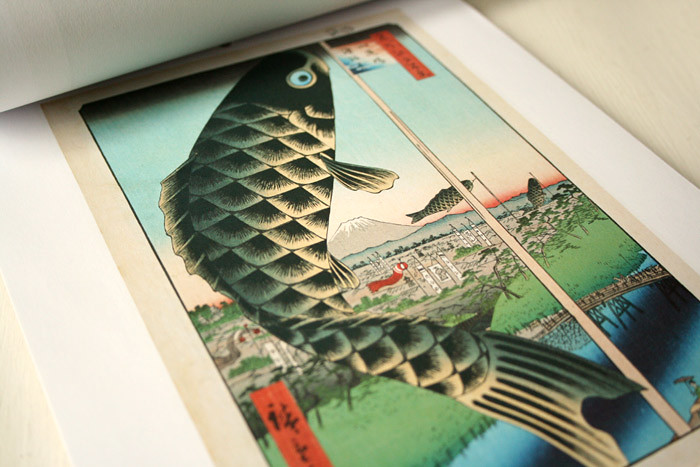
Ok, so this is the amount of Mondays we have to endure throughout 2012. Doesn't look like a lot actually:
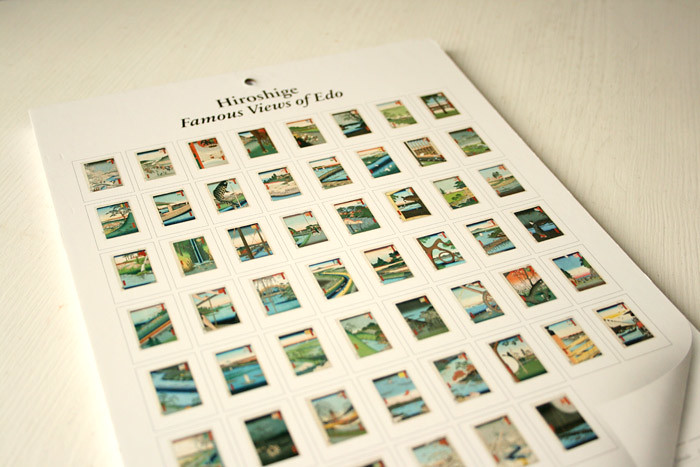
And speaking again of shopping: If you've fallen in love with this too, you can purchase it online
here at Taschen for cheap since the year's begun now.
Yay, the rice is done. What a difference such a little grain filled bag can make. The rice has a nutty smell and a creamy brown/white colour, and is full of exciting new flavours among is grains.
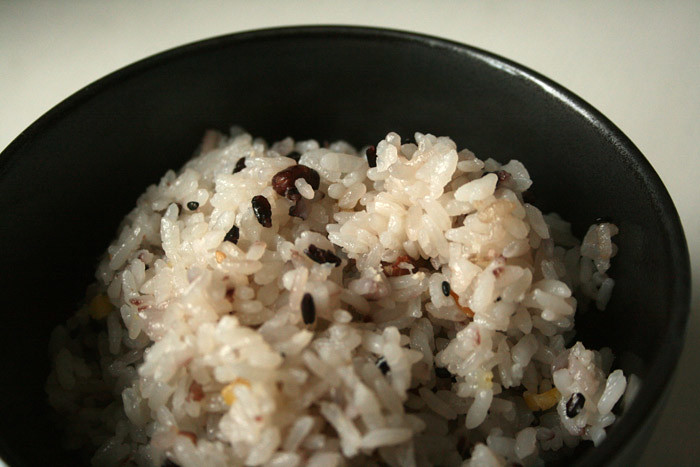
It tastes great. It's not a super intrusive attack on the traditional rice, more like a fun variation and a nutty boost.
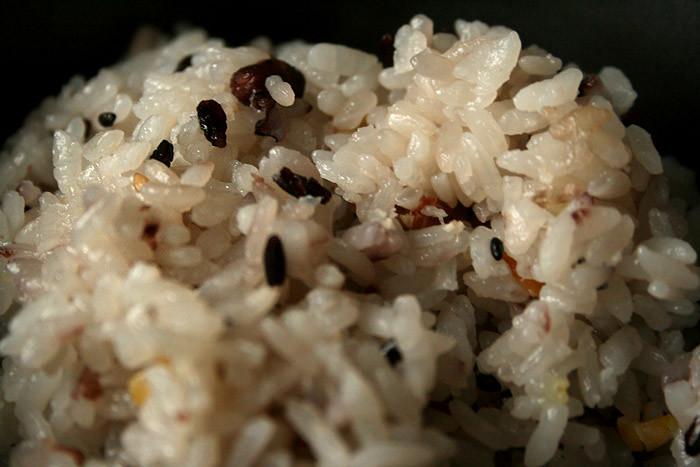
Happy winter rice time from Skankynavia.

 The other day at my local Asian market -- which is usually not very well equipped since importing food from Asia to an unsignificant little island kingdom like Denmark is incredibly pricey -- I found these bags of grains. And I remembered the many crazy versions of rice I often came across when living in Tokyo. Blue, green, dotted in all colours, with grains, with beans, with nuts, anything you'd be sane enough to drop in a rice cooker.
Japanese consumers are obsessed with the terms "fresh" and "new". In supermarkets and konbinis in Japan products are constantly being introduced, killed-off or moved around in the store to create the impression of variation and new experiences every time you enter the shop = more consumption, more shopping.
The other day at my local Asian market -- which is usually not very well equipped since importing food from Asia to an unsignificant little island kingdom like Denmark is incredibly pricey -- I found these bags of grains. And I remembered the many crazy versions of rice I often came across when living in Tokyo. Blue, green, dotted in all colours, with grains, with beans, with nuts, anything you'd be sane enough to drop in a rice cooker.
Japanese consumers are obsessed with the terms "fresh" and "new". In supermarkets and konbinis in Japan products are constantly being introduced, killed-off or moved around in the store to create the impression of variation and new experiences every time you enter the shop = more consumption, more shopping.
 Shibuya: A normal day of skanky shopping.
As fellow Umamimart writer Yoko has mentioned several times in her Japanify coloum, new flavours of a well known product are introduced constantly, and quite often those flavours are more a gimmick than a real addition to its brand. Like Green Tea Coca Cola, Vanilla Licorice Beer or Mango Pudding Kit Kat. They may not taste super good, but they invoke a sensation in the consumer's brain and a quick 10 second reminder of its brand in the surrounding cacophony of other brands across the globe. It's all about staying afloat in people's minds, no matter the cost.
Shibuya: A normal day of skanky shopping.
As fellow Umamimart writer Yoko has mentioned several times in her Japanify coloum, new flavours of a well known product are introduced constantly, and quite often those flavours are more a gimmick than a real addition to its brand. Like Green Tea Coca Cola, Vanilla Licorice Beer or Mango Pudding Kit Kat. They may not taste super good, but they invoke a sensation in the consumer's brain and a quick 10 second reminder of its brand in the surrounding cacophony of other brands across the globe. It's all about staying afloat in people's minds, no matter the cost.
 Caramel Corn candy bags - why just one corn flavour when we can have six? Strawberry Corn, Tomato Corn, Peanut Corn, Green Tea Corn, Almond Corn and Vanilla Corn.
Japan makes you buy stuff -- and that's exactly what many urban Japanese do: work/eat/shop/sleep (wait hold on, they barely sleep since their work schedule is so intense. And also there's very little sex involved -- the Japanese are so over relationship fornication according to many recent studies. Many young, urban Japanese past their 20's prefer to stay living at home with their parents and then spend their salary on fun with friends, foreign travels, izakaya dinners and shopping. And the shops know that.
Which means whenever you find yourself on a first class seat to Tokyo, make sure you brought lots of empty suitcases to bring back your new junk.
Caramel Corn candy bags - why just one corn flavour when we can have six? Strawberry Corn, Tomato Corn, Peanut Corn, Green Tea Corn, Almond Corn and Vanilla Corn.
Japan makes you buy stuff -- and that's exactly what many urban Japanese do: work/eat/shop/sleep (wait hold on, they barely sleep since their work schedule is so intense. And also there's very little sex involved -- the Japanese are so over relationship fornication according to many recent studies. Many young, urban Japanese past their 20's prefer to stay living at home with their parents and then spend their salary on fun with friends, foreign travels, izakaya dinners and shopping. And the shops know that.
Which means whenever you find yourself on a first class seat to Tokyo, make sure you brought lots of empty suitcases to bring back your new junk.
 Tokyo, 2008: Psyched out Anders high on a mixture of sugary green tea ice cream overdose and Tokyu Hands toy department shopping frenzy:
"Look, Yoko -- I'm shopppiiing! How about this bed? Should I buy it? Does it fold for the plane ride? What do you think, Yoko? Oh those sheets over there are lovely, I'll take two of those! Wow, check out those Muji designer bunny slippers! Do you think they come in white male sizes?"
Tokyo, 2008: Psyched out Anders high on a mixture of sugary green tea ice cream overdose and Tokyu Hands toy department shopping frenzy:
"Look, Yoko -- I'm shopppiiing! How about this bed? Should I buy it? Does it fold for the plane ride? What do you think, Yoko? Oh those sheets over there are lovely, I'll take two of those! Wow, check out those Muji designer bunny slippers! Do you think they come in white male sizes?"
 Yoko: "Get me out of here".
Yoko: "Get me out of here".
 Chopped baby bunny meat burger. Kidding. Sort of, I think.
But sometimes this crazed up variation shopping machine isn't so bad. It's actually quite exciting now and then. And I really really miss this energy and creativity among the brands in Danish supermarkets. Every five years there MIGHT be introduced a new flavour of a classic chocolate bar here, but it will probably be "Almond" or "Soft Toffee" or something generic, really thought-over and well-tested with consumers. Yawn, you say? I agree. Then again, Red-Bean-Paste-Whole-Grain-Spearmint Kit Kat probably wouldn't sell truckloads here. However, a little craziness now and then would be fun here in Denmark.
Back to the rice mix:
Chopped baby bunny meat burger. Kidding. Sort of, I think.
But sometimes this crazed up variation shopping machine isn't so bad. It's actually quite exciting now and then. And I really really miss this energy and creativity among the brands in Danish supermarkets. Every five years there MIGHT be introduced a new flavour of a classic chocolate bar here, but it will probably be "Almond" or "Soft Toffee" or something generic, really thought-over and well-tested with consumers. Yawn, you say? I agree. Then again, Red-Bean-Paste-Whole-Grain-Spearmint Kit Kat probably wouldn't sell truckloads here. However, a little craziness now and then would be fun here in Denmark.
Back to the rice mix:
 Super cute package.
It says げんきなこくもつ which best can be translated as "happy, vigouris richness". Which is exactly what it brings to your plain, white boring rice.
Super cute package.
It says げんきなこくもつ which best can be translated as "happy, vigouris richness". Which is exactly what it brings to your plain, white boring rice.
 Danish ingredient list stuck on the back by the import company lists the ingredients:
Danish ingredient list stuck on the back by the import company lists the ingredients:
 This is 15 kinds of rice/grain mix: Gluten rice, black rice, corn, red beans,, barley, buckwheat, pearl barley, black soy beans, black seseame, white sesame, brown rice, white sorghum, gluten foxtail millet, gluten millet and amarand grains.
WOW! That's a whole lotta grainz.
This is 15 kinds of rice/grain mix: Gluten rice, black rice, corn, red beans,, barley, buckwheat, pearl barley, black soy beans, black seseame, white sesame, brown rice, white sorghum, gluten foxtail millet, gluten millet and amarand grains.
WOW! That's a whole lotta grainz.
 Sounds like something the organic crazies here in Copenhagen would happily sprinkle on their tofu ice cream.
It says this bag goes with 500g rice which is exactly 4 cups.
Many Western people claim that rice doesn't really taste of anything and it's all the same. Well, not quite.
Sounds like something the organic crazies here in Copenhagen would happily sprinkle on their tofu ice cream.
It says this bag goes with 500g rice which is exactly 4 cups.
Many Western people claim that rice doesn't really taste of anything and it's all the same. Well, not quite.
 The world of Japanese rice is an abundant cornicopia of brands that offer thousands of different textures, subtle flavours and qualities.
My latest disappointment in my fellow Danes was last week when I went to the Kung Fu Izakaya Bar in Copenhagen. A Japanese izakaya-inspired place with wooden interiors and cozy lighting. All was good until we sat down and the starter miso soup with a bowl of Indian basmati rice was placed in front of me. SHOCK HORROR! You can NOT serve Indian rice in a Japanese izakaya, it's like serving expensive salmon nigiri sushi with ketchup on the side (something that will send you straight to hell). Needless to say the rest of the dishes were also an abomination and we left hardly having touched the food.
The world of Japanese rice is an abundant cornicopia of brands that offer thousands of different textures, subtle flavours and qualities.
My latest disappointment in my fellow Danes was last week when I went to the Kung Fu Izakaya Bar in Copenhagen. A Japanese izakaya-inspired place with wooden interiors and cozy lighting. All was good until we sat down and the starter miso soup with a bowl of Indian basmati rice was placed in front of me. SHOCK HORROR! You can NOT serve Indian rice in a Japanese izakaya, it's like serving expensive salmon nigiri sushi with ketchup on the side (something that will send you straight to hell). Needless to say the rest of the dishes were also an abomination and we left hardly having touched the food.
 This is my preferred rice at the moment. Hitomebore rice, a middle grain sort which is developed in Japan but grown in the US. I used to buy cheaper brands at the Asian market, but this is so much better. It's about $23 for a bag of 2.5 kg which is probably a little pricey for American or Japanese standards.
This is my preferred rice at the moment. Hitomebore rice, a middle grain sort which is developed in Japan but grown in the US. I used to buy cheaper brands at the Asian market, but this is so much better. It's about $23 for a bag of 2.5 kg which is probably a little pricey for American or Japanese standards.
 The owner of my local Asian market told me yesterday that their container from Japan was finally delivered after being held back for two months in customs since there are only 3 freight companies in Denmark that scan for radiation contamination (supposedly everything from Japan is scanned before crossing the border to the EU. Hmm I didn't know that, but I guess it makes sense).
So again, back to the rice:
The owner of my local Asian market told me yesterday that their container from Japan was finally delivered after being held back for two months in customs since there are only 3 freight companies in Denmark that scan for radiation contamination (supposedly everything from Japan is scanned before crossing the border to the EU. Hmm I didn't know that, but I guess it makes sense).
So again, back to the rice:
 I put 4 cups of rice in my rice cooker bowl. Wash gently 4-5 times until the water is somewhat clear.
I put 4 cups of rice in my rice cooker bowl. Wash gently 4-5 times until the water is somewhat clear.
 Pour out all water, add approx 4 cups of new fresh water and let it soak for 10 minutes.
Put in the bag of happy, vigorious richness and mix around.
Pour out all water, add approx 4 cups of new fresh water and let it soak for 10 minutes.
Put in the bag of happy, vigorious richness and mix around.
 Place the cooking bowl in the rice cooker and start cooking.
While we wait for the vigorious rice, I want to show you the best Christmas present I got this year: A "Famous Views of Edo" week calendar from Taschen, painted by one of the most famous uki-e painters Hiroshige (1797 – 1858).
Place the cooking bowl in the rice cooker and start cooking.
While we wait for the vigorious rice, I want to show you the best Christmas present I got this year: A "Famous Views of Edo" week calendar from Taschen, painted by one of the most famous uki-e painters Hiroshige (1797 – 1858).
 Edo was the old name for present day Tokyo and the paintings in the calendar show the nature around the old capital, the life of its inhabitants and the many incredibly scenes from a world long gone.
Edo was the old name for present day Tokyo and the paintings in the calendar show the nature around the old capital, the life of its inhabitants and the many incredibly scenes from a world long gone.
 What must a foreigner have thought when coming to Japan the first time back in this age? Everything must have been so aesthetic, so beautiful -- and yet so raw. A hard-knock life.
What must a foreigner have thought when coming to Japan the first time back in this age? Everything must have been so aesthetic, so beautiful -- and yet so raw. A hard-knock life.

 Ok, so this is the amount of Mondays we have to endure throughout 2012. Doesn't look like a lot actually:
Ok, so this is the amount of Mondays we have to endure throughout 2012. Doesn't look like a lot actually:
 And speaking again of shopping: If you've fallen in love with this too, you can purchase it online here at Taschen for cheap since the year's begun now.
Yay, the rice is done. What a difference such a little grain filled bag can make. The rice has a nutty smell and a creamy brown/white colour, and is full of exciting new flavours among is grains.
And speaking again of shopping: If you've fallen in love with this too, you can purchase it online here at Taschen for cheap since the year's begun now.
Yay, the rice is done. What a difference such a little grain filled bag can make. The rice has a nutty smell and a creamy brown/white colour, and is full of exciting new flavours among is grains.
 It tastes great. It's not a super intrusive attack on the traditional rice, more like a fun variation and a nutty boost.
It tastes great. It's not a super intrusive attack on the traditional rice, more like a fun variation and a nutty boost.
 Happy winter rice time from Skankynavia.
Happy winter rice time from Skankynavia.


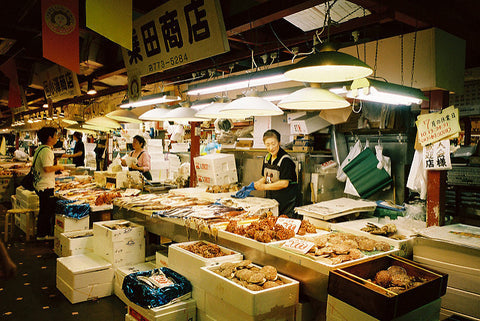


Comments (4)
Anders, sorry for this delayed comment, we’ve all been a bit delinquent these days.
Awesome post and photos! I love your calendar shot with the rice. So wintery.
Wanted to ask about your Asian market. Is it all Asian goods? Chinese, Korean, Japanese? Indian? Run by Chinese? Japanese? I am curious. Is it just a little market? Fancy part of town? Gourmet or run-of-the-mill?
I am so curious! Maybe you can post on it sometime.
Also, the fact that the foods from Japan were stopped at customs for radiation testing is so interesting. I am happy Denmark is taking cautious measures, and I wonder what the US is doing.
Again, thanks for the post!!!
Please tell me the address to this Asian market. I love rice and spicing it up with a mix would be brilliant. ^^
Hey guys.
@Henrik: thanks for reading the blog.
I regularly shop at two “Asian markets” in Copenhagen:
“Sachie” on Fiolstraede 32 which is small and Japanese owned. It has some special Japanese imported stuff, for example good quality Japanese rice which you can’t get anywhere else in Copenhagen. Like the above Hitomebore kind.The problem with this shop is that it’s always half empty – deserted shelves and not enough products to fill up the space even though it’s small. Probably due to people not buying that much there, I guess they have to avoid buying stuff that’ll just get old and never sold. Then there’s “Den Kinesiske Købmand” on Noerre Voldgade 64 which is Chinese/Japanese owned and is the Asian supermarket which I visit the most. You can get the rice mix which I write about in this post, and also a lot of other basic products, along with lots of Thai, Chinese and Korean specialities. They are usually well stocked as they seem to cater to more customers and therefore make more $$$.
They also opened a small branch in Torvehallerne.
Still though I wish more Japanese veggies were available here *sigh.
One of my friends gave me a packet of healthy rice mix – I love it! It’s an extra oomph to rice and makes the meal more interesting. I think it’s all the rage in Japan, right?